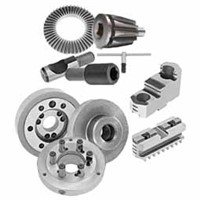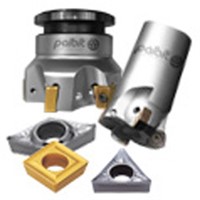
HVH Industrial Solutions is a leading distributor of machining products
HVH offers machining tools and accessories, including work holdings, round toolings, rotary tool holders, indexable tooling, straight holders, collets, tool posts, inserts, and other products. Machining tools and products are essential in many industrial applications and workplaces; for example, work-holding tools are machines used to hold products, especially geometrically uniquely shaped products, in a fixed position during the machining process.
HVH Industrial works with manufacturers' specialized engineering teams to meet our customer's requirements and highest quality standards.
If you have any questions, write us via live chat (one of our team members will answer your questions), call, or send us a quote request (we typically reply in less than one hour). The HVH team is always ready to help you.
 1(866)577-4040
1(866)577-4040
or
Machining
Manufacturers
Machining tools are an essential component in the manufacturing industry. Machining is the process of shaping and finishing materials to precise dimensions and tolerances using various cutting tools and techniques. The goal of machining is to produce high-quality parts that meet the requirements of a specific application.
What is machining?
Machining is a subtractive manufacturing process that involves removing material from a workpiece to create a desired shape or finish. The process is typically performed on a lathe, milling machine, or other machine tool using various cutting tools, such as drills, taps, end mills, and reamers. Machining can be done manually or using computer numerical control (CNC) machines that use pre-programmed instructions to control the cutting tool's movement.
History of machining
The history of machining dates back to the ancient Egyptians and Greeks, who used simple tools to shape and finish metal objects. However, it was not until the Industrial Revolution in the 18th and 19th centuries that machining became a critical manufacturing process. The invention of machine tools, such as the lathe and the milling machine, revolutionized machining and made it possible to produce complex parts with greater precision and efficiency.
Types of Machining Tools
Machining is a process of shaping and removing material from a workpiece using various cutting tools. In order to ensure the successful execution of the process of machining, it is necessary to utilize two key components: holding and cutting tools. Holding devices are of paramount importance as they provide stability and accuracy to the workpiece during the machining process. On the other hand, cutting tools are utilized to shape and remove material from the workpiece to attain the desired end product.
Holding Devices
Holding devices are designed to provide stability and secure the workpiece during the machining process. They are available in a range of designs and sizes, from basic clamps to sophisticated chucks and collets. The type of holding device utilized is dependent on various factors such as the size and shape of the workpiece, the machining process, and the machine tool being used.
One of the most commonly used holding devices is the vise. Vises are simple to use and can be adjusted to accommodate various sizes of workpieces. They come in a variety of designs such as standard and precision vises and are well-suited for drilling and milling applications. Another popular holding device is the chuck, which is used to secure round or irregularly shaped workpieces and can be manually or automatically operated.
Collets, which are designed to hold cylindrical workpieces, are another type of holding device and are available in various sizes and are designed to provide maximum accuracy and repeatability. Collets are commonly utilized in turning and milling applications.
Cutting Tools
Cutting tools are designed to shape and remove material from the workpiece to achieve the desired end product. They come in various shapes and sizes, including drills, end mills, and lathe tools. The selection of the appropriate cutting tool depends on factors such as the material being machined, the desired finish, and the machining process being used.
Drills are used to create holes in the workpiece. They come in a range of sizes and designs, such as twist drills and indexable drills. End mills are used for milling operations and can produce a variety of shapes such as slots, pockets, and contours. Lathe tools are used in turning operations to shape the workpiece into the desired form.
The proper selection and use of cutting tools can have a profound impact on the efficiency and accuracy of the machining process. Using the wrong tool or a dull tool can result in poor surface finish, increased machining time, and tool failure. To ensure optimal performance, cutting tools should be regularly inspected and replaced as required.
Benefits of Machining Tools
Precision
One of the most significant benefits of machining tools is their ability to produce parts with high precision. These tools can produce parts with tolerances as low as a few microns, ensuring that the parts meet the required specifications.
Efficiency
Machining tools are also highly efficient, capable of producing parts in large quantities quickly. This efficiency makes machining tools an ideal choice for mass production.
Versatility
Machining tools are highly versatile and can be used to create a wide range of parts, from simple to complex. This versatility makes them a valuable tool in a wide range of industries.
Cost-effective
Machining tools can be cost-effective, especially when used for mass production. The ability to produce parts quickly and efficiently can reduce production costs, making machining tools a cost-effective option for many industries.
In conclusion, machining tools have revolutionized the manufacturing industry by providing the ability to produce complex and precise parts in large quantities. These tools are used in a wide range of industries, including aerospace, automotive, medical, and more. The benefits of machining tools, including precision, efficiency, versatility, quality, and cost-effectiveness, make them essential tools for manufacturing.








